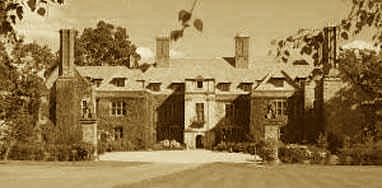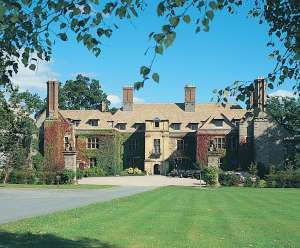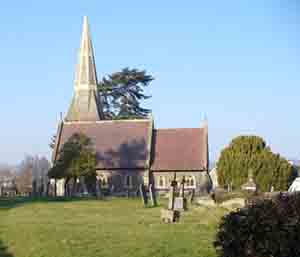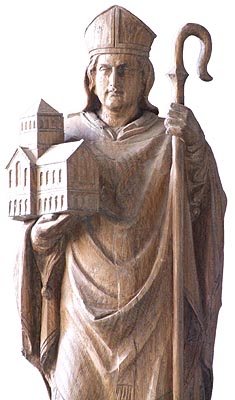
| |
| Home |
| Location |
| Directions |
| Accommodation |
| Wedding List |
| Wedding Album |
| RSVP |
Llangoed Hall |
|
 Llangoed Hall is a luxurious country house hotel, situated on the banks of the
river Wye in mid Wales with views over the Black Mountains. Llangoed Hall is a luxurious country house hotel, situated on the banks of the
river Wye in mid Wales with views over the Black Mountains.
Based in the heart of Wales and resting on the site of the former Welsh Parliament, Llangoed Hall commands spectacular, uninterrupted views of the Black Mountains. Each room is individually decorated with antique furniture, fabrics from Elanbach, Sir Bernard Ashley's textile printing company based in the grounds, and work by artists such as Whistler, Sickert and Augustus John. It is the location that, after much searching, we have chosen for our wedding reception. |
|
St Cynog's Church, Boughrood |
|
 A BRIEF HISTORY In August 1694 the then Archbishop of Canterbury visited Brecon to enquire as to the state of the churches in the area. The Churchwardens of each church were required to prepare a Presentment of the condition of their church. The Churchwardens in Boughrood at the time, Stanley Bevan and William Prosser, wrote of Boughrood church as follows; Church is in indifferent repair, except the King's arms being somewhat thereof stayned, The chancel wants glazing the windows, the which belongeth to the parson or vicar, Churchyard fenced and preserved from animals to our knowledge, No dwelling-house or outhouses for our vicar or curat in our parish: and as for the glebe lands there is some which is to our knowledge about 13 acres or thereabouts. There was some wood cut down uppon the glebelands this severall years agoe, but wee cannot justifie it by reason we are not well acquainted with glebelands. Our parson, vicar or curat hath noe residence within our parish, and our, parson or vicar doth not preach any sermon uppon the Lord's Day but sometimes. With unglazed windows in the chancel and the roof leaking so as to stain the King's arms the church was, in a pretty poor way. In 1818 J. Williams wrote that the church; Consists of a nave and chancel divided by a timber partition, a tower containing three bells, a porch having a lavacrum to the right of the entrance. The interior is dark, irregularly pewed and contains nothing remarkable. Things had obviously not improved in the intervening years. A fuller description is supplied by Sir Stephan Glynn who visited the church on May 20th 1851. He wrote; A small church in a lovely situation near the Wye, It consists of nave and chancel with out aisles, and a small western steeple of stone in its lower part having slits for openings and a wooden belfry. A south porch is of mixed stone and wood, The chancel arch is a very rude pointed one. Inthe nave are some bad modern windows and two single ones with trefoil heads; of the latter kind is one also in the chancel. The East window is a modern imitation of the Middle English pointed with a transom, containing indifferent painted glass. There is a handsome new font the bowl octagonal with middle pointed panelling and octagonal stem. The old font with plain circular bowl is in the churchyard. The interior is pewed but tolerably neat. The churchyard is of a very large size and only partially used. This description shows that the Revd Henry de Winton had begun the work that was to be a great joy to him; the restoration of Boughrood church. The gift of the living was with the influential de Winton family. Henry had for some time been curate to his father Walter but by 1850 he was vicar. He began by attempting to tidy up the existing church hence the new font, painted glass and better arrangement of pews. However by 1854 it was clear that the church was in such poor condition that it was necessary to rebuild it. C.H. Howell designed the new church in a "Determined Geometrical Style." The font of 1851 was retained and so were the bells but the rest was replaced quite possibly, as was often the case at the time, on the original ground plan. The new church was a fine addition to the village with its delicately carved floral capitals, each depicting a different flower of the hedgerow, and the various faces proceeding down the nave as corbels upon which the timbers for the roof rest. In the chancel there are angels to proclaim God’s praise. Above all this the new tower and spire rose as a landmark. The glory of the new led the Rev Francis Kilvert to write in 1872 that he had heard Crichton report that; Old Boughrood Church was a most miserable place. The choir sat upon the altar and played a drum. Now they had fine new choir stalls with more floral detail and a fine new stall and desk for the Vicar with carved figures on the arm rests. Unfortunately time left its mark and structural defects in the spire meant that in 1978 it had to be removed. The proportion of the church was destroyed and an important landmark lost. The loss was keenly felt by all those for whom it meant, when seen from a distance, that home was near. However, in 1999 the possibility of the restoration of the spire along with other major works on the church was first mooted. Initially it seemed to be beyond hope that this dream should be realised but as the funding applications went in it seemed to become more likely. Then in 2001, just as things seemed more hopeful, circumstances seemed to conspire against the project; just as the small congregation were told that they would have to raise in excess of £36,000 as their contribution to the overall project cost Foot and Mouth Disease closed the countryside down and caused immense financial hardship to the farming community. Boughrood rose to the challenge and raised the money in just one year in the process helping the community come together again after the enforced isolation of Foot and Mouth. We raced ducks down the river, had a huge bonfire with fireworks, tasted home made wines, invited Father Christmas to join us on a decorated trailer for carol singing around the village, danced on St David’s Day, questioned our sporting knowledge and many other fun events. In 2004 work finally began and a display in the church charts the progress of the restoration of the spire. Topped out with a wonderful golden weathervane it is a landmark for all who pass along the Wye Valley. There is always work to be done when maintaining an old building and large churchyard but a loyal band of supporters ensures that the church and churchyard are well cared for. We hope that you enjoy your visit to our church. |
|
St Cynog Himself |
|
 St. Cynog was born around 434 A.D. His name in Welsh is Cynog, in Latin Cunocius and in English, Cunnock. St. Cynog was the eldest son of King Brychan of Brycheiniog, by Banhadlwedd, the daughter of the Irish King Banhadle from around Llanrhaiadr ym Mochnant in Powys whom he violated while a hostage at the Powysian court. She presumably returned with Brychan to Brycheiniog for Cynog is said to have been born at his father's Royal Court at Caer Efong (Y Gaer). Brychan had him baptised and gave him a heavy iron 'torc from heaven,' covered in gold, which he had worn on his arm. Cynog wore it on his head. His maternal grandfather was probably expelled from Powys by St. Germanus, for Cynog was later offered his crown, but only over his Irish dominions. The saint refused but was, at times, appointed governor of Brycheiniog during his father's absence. In his youth, Cynog retired from his father's court to a hermitage not far from the Brecon to Battle road, about a mile from Caer Efong (Y Gaer), his father's capital. He spent his life ministering to the religious needs of the people of Brycheiniog, as well as making sojourns to other Welsh kingdoms where churches dedicated to him may still be found. He even travelled over the Bristol Channel to Cerniw (Cornwall), staying for some time at Both-Cynog (Boconnoc), near some of his siblings. At Caer Wedros in Ceredigion, a young widow begged him to save her and her children from the ravaging 'ormests' (or invaders), a race of cannibal giants who inhabited the hills and the woods and attacked the locals at night. Cynog resolved to stand guard, praying at the woman's door until morning. When, the ormests arrived, the saint persuaded their chief to spare the woman and her family in return for allowing him to cut a large slice of flesh from the saint's own thigh. The chief giant relishing such a delicacy however, came back for more the following night. Divine intervention inspired Cynog to defend himself with his torc and, striking his opponent with a heavy blow to the head, he slew him. His followers fled and were never seen again. "A sheep's white wool" is later said to have grown over Cynog's own injury. Years later, a blacksmith and his friends were scoffing at the story of the giant's 'death-by-torc', when St. Cynog passed by. The blacksmith snatched the holy torc from him and struck it upon his anvil in scorn, exclaiming that it never killed an ormest. At that moment, a little splinter of metal flew out from the torc and pierced the smith's brain so that he immediately dropped down dead! In later life, St. Cynog was desirous of a more stable form of solitude, so he joined a community of religious men leading an organised hermitical life upon Y Fan Oleu (the Van), a mountain in the parish of Merthyr Cynog. There he built himself a small hermitage under a steep rock near the mountain's summit. Cynog and his followers lived by the labour of their hands and had no water except that which they fetched from the river at the foot of the mountain. The hermits continually bemoaned the long climb back up the steep hill, but Cynog underwent the journey very cheerily and reprehended the others for their sloth, for he considered such labour holy in itself. Thus the other hermits came to resent Cynog's presence. Resentment soon turned to hatred when the Lord sent Cynog a miraculous spring above his little cell, in consideration of his aged state. The hermits resolved to murder poor Cynog in order to gain access to his water supply. Mounting the rock one Sunday morning on the 8th October 492, they found him at prayer, his feet in the crystal spring. They ran at him furiously and cut off his head with a sword, which was then dropped into the well. As Cynog's head hit the water the spring immediately dried up. The saint, however, continued to walk about with his head, first hanging from his body and then taken up by his hands. He carried it down the hill and onto some rising ground. At this point, one of the hermit's snatched Cynog's famous torc from under his habit and the saint dropped his head under a bramble bush. He was buried at this spot and the old parish church of Merthyr Cynog was raised as a martyrium over his grave. There are many churches dedicated to his memory in Wales besides our own and he is also honoured in Brittany (Benedictines). |
|